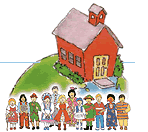|
Home |
Project Overview
Introduction
The "Letters to Santa Claus" activity is not a new one. Teachers and parents
have always helped children write to Santa.
This bearded, fat, jolly, red-suited folkloric old man sometimes represents different things to different people. But coming as he does in the dead of winter (in the northern hemisphere), he seems mostly to symbolize hope.
This lesson is based on the experiences of teachers who have used email to send letters to and from Santa in projects since 1985.
It is a lesson that is especially well-designed for the newcomer to Internet-working, yet one that more advanced teachers and their students enjoy using every year.
The project concept is a simple one:
- Students in the primary class write letters to Santa using a word
processor. They send their letters via electronic mail to their partner class.
- Students in the older class write replies to each primary letter and send them back via email.
This project suits a wide cross-section of students. Past participants have included:
- bilingual
- communicatively handicapped
- deaf and hard of hearing
- gifted
- continuation
- opportunity
Improve Student Skills:
- Academically
The project strengthens students' writing. Primary students want their letter to Santa to be "just right", and secondary students feel such a high degree of responsibility to the task that they also want their work to be their best. Students gladly write, edit, revise and perfect their letters.
- They even get quite a bit of practice reading, because they want to read
each others' letters and compare the contents.
- Socially
One of the most noteworthy results of this project is the cooperative mode that the students seem automatically to slide into so effortlessly. They want to help each other, to compare what they have written with what others in the class have done. The desire to cooperate is obvious, natural and strong.
- Technically
In video interviews taken after they have completed the project, students state that they feel more comfortable using the computer keyboard and the word-processing program. They are also intrigued and interested in learning about electronic transfer of information.
Improve Teacher Skills:
Much has been said regarding the unfortunate isolation facing the teacher of today. Only truly extraordinary teachers seem to be able to fight the impossible obstacles that prevent them from sharing ideas with colleagues.
For many teachers, participation in this project is their first step into an electronic network. After experiencing this project, teachers see the possibilities of networking with other teachers, and hearing about new approaches to old problems.
Letters must be composed in a relatively short time... the project must be completely wrapped up by the second week in December. For that reason, you find it advantageous if you have access to a lab full of computers. That way, you can have your entire class working on the project at the same time.
Whether you have your students working in pairs or by themselves is sometimes more a question of how much equipment you have than anything else. Therefore, the number of students per computers is flexible.
Lesson Plans and Project Guides
You are welcome to use our teacher-tested project guide. Use the menu at the top.
|
Contact Global SchoolNet Foundation | Our Privacy Policy | Terms of Use | Link to Us © 2001 LIGHTSPAN,Inc under license to Global SchoolNet Foundation . All rights reserved. Last Update: 24 April 2004 |

